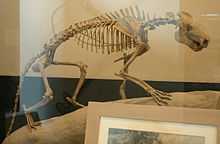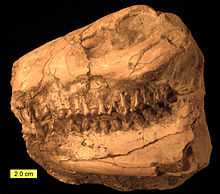Merycoidodontoidea
| Merycoidodontoidea Temporal range: 35–5Ma | |
|---|---|
 | |
| Reconstructions of various Miocene oreodonts, including Merycochoerus, Promerycochoerus, and Brachycrus | |
| Scientific classification | |
| Kingdom: | Animalia |
| Phylum: | Chordata |
| Class: | Mammalia |
| Order: | Artiodactyla |
| Suborder: | Tylopoda |
| Family: | †Merycoidodontidae Thorpe (1923) |
| Subfamilies | |
| |
Merycoidodontoidea, sometimes called "oreodonts," or "ruminating hogs", is an extinct superfamily of prehistoric cud-chewing artiodactyls with short faces and fang-like canine teeth. As their name implies, some of the better known forms were generally hog-like, and the group was once thought to be a member of Suina, the pigs, peccaries and their ancestors, though recent work indicates they were more closely related to camels.[2] "Oreodont" means "mountain teeth", referring to the appearance of the molars. Most oreodonts were sheep-sized, though some genera grew to the size of cattle. They were heavy-bodied, with short four-toed hooves and comparatively long tails.
The animals would have looked rather pig- or sheep-like, but features of their teeth indicate they were more closely related to camelids. They were most likely woodland and grassland browsers, and were widespread in North America during the Oligocene and Miocene. Later forms diversified to suit a range of different habitats. For example, Promerycochoerus had adaptations suggesting a semiamphibious lifestyle, similar to that of modern hippos.[3]
Taxonomy

The two families of oreodonts are the Merycoidodontidae (originally known as Oreodontidae) which contains all of the advanced species, and the Agriochoeridae, smaller, primitive oreodonts. Together they form the now-extinct suborder Oreodonta. Oreodonts may have been distantly related to pigs, hippopotamuses, and the pig-like peccaries. Indeed, some scholars place Merycoidodontidae within the pig-related suborder Suina (Suiformes). Other scholars place oreodonts closer to camels in the suborder Tylopoda. Still other experts put the oreodonts together with the short-lived cainotheres in the taxonomic suborder Ancodonta comprising these two groups of extinct ancodonts. All scholars agree, however, that the oreodont was an early form of even-toed ungulate, belonging to the order Artiodactyla. Today, most evidence points towards the oreodonts being tylopods, along with camels, xiphodonts, and protoceratids.
Over 50 genera of Oreodonta have been described in the paleozoological literature. However, oreodonts are widely considered to be taxonomically oversplit,[4][5] and many of these genera may prove to be synonymous. The last researchers to fully review oreodont taxonomy, C. Bertrand Schultz and Charles H. Falkenbach,[6] have been criticized for erecting excessive numbers of genera, based in part on apparent anatomical differences between different specimens that were actually taphonomic deformations due to postburial forces.[4] Undeformed skulls would be placed in one genus, while skulls crushed from side to side would be placed in a second genus and skulls crushed from front to back would be placed in a third genus. Researchers are beginning to restudy oreodonts and synonymize many genera, but only a few groups have been reviewed.[4][7][8]
Natural history
This diverse group of stocky prehistoric mammals grazed amid the grasslands, prairies, or savannas of North and Central America throughout much of the Cenozoic era. First appearing 48 million years ago (Mya) during the warm Eocene epoch of the Paleogene period, the oreodonts dominated the American landscape 34 to 23 Mya during the dry Oligocene epoch, but they mysteriously disappeared 4 Mya during the colder Pliocene epoch of the late Neogene period.
Today, fossil jaws and teeth of the Oreodonta are commonly found amid the 'Oreodon beds' (White River fauna) of the White River badlands in South Dakota, Nebraska, and Wyoming. Many oreodont bones have also been reported at the John Day Fossil Beds National Monument in Oregon. Some oreodonts have been found at Agate Fossil Beds National Monument. In Oligocene/Miocene Florida, oreodonts are surprisingly rare. Instead of the swarms found elsewhere, only six genera of oreodonts are known to have ranged there, and only one, Mesoreodon, is known from a single, good skeleton.
Lifestyle
The majority of oreodonts are presumed to have lived in herds, as suggested by the thousands of individuals in the various mass mortalities seen in the White River Badlands, Oreodont beds, or Chula Vista.
Diversity

Oreodonts underwent a huge diversification during the Oligocene and Miocene, adapting to a number of ecological niches, including:
- Semiaquatic - hippo-like Promerycochoerus
- Trunked browser - tapir-like Brachycrus
- Large grazer - cow-sized Eporeodon
- Medium grazer - goat-like Merycoidodon
- Small desert herbivore - goat- to cat-sized Sespia
- Medium desert herbivore - Mesoreodon and the ubiquitous Leptauchenia
Classification
The family Merycoidodontidae is divided into 10 subfamilies, with six genera not included in any subfamily (incertae sedis) because they are either regarded as basal oreodonts, or their status within the family remains uncertain.
- Family †Merycoidodontidae
- subfamily incertae sedis
- †Aclistomycter
- †Merychyus
- †Pseudogenetochoerus
- †Pseudoleptauchenia
- Subfamily †Oreonetinae
- †Bathygenys
- †Megabathygenys
- †Oreonetes
- †Bathygenys
- Subfamily †Leptaucheniinae[7]
- Tribe †Leptaucheniini
- †Limnenetes
- Tribe †Sespiini
- Subfamily †Merycoidodontinae (syn. Oreodontinae)[4]
- †Merycoidodon (syn. Blickohyus, Genetochoerus, Oreodon, Otionohyus, Paramerycoidodon, Prodesmatochoerus, Promesoreodon, Subdesmatochoerus)
- †Mesoreodon
- Subfamily †Miniochoerinae[4]
- †Miniochoerus (syn. Paraminiochoerus, Parastenopsochoerus, Platyochoerus, Pseudostenopsochoerus, Stenopsochoerus)
- Subfamily †Desmatochoerinae
- †Desmatochoerus
- †Eporeodon
- †Megoreodon
- Subfamily †Promerycochoerinae
- †Promesodreodon
- †Promerycochoerus
- †Merycoides
- Subfamily †Merychyinae
- Subfamily †Eporeodontinae
- †Dayohyus (syn. Eucrotaphus deemed nomen dubium)
- †Eporeodon
- Subfamily †Phenacocoelinae
- Subfamily †Ticholeptinae
- †Mediochoerus
- †Ticholeptus
- †Ustatochoerus
- Subfamily †Merycochoerinae
- subfamily incertae sedis
References
- ↑ Palmer, D., ed. (1999). The Marshall Illustrated Encyclopedia of Dinosaurs and Prehistoric Animals. London: Marshall Editions. p. 270. ISBN 1-84028-152-9.
- ↑ Spaulding, M., O'Leary, M.A. & Gatesy, J. (2009): Relationships of Cetacea (Artiodactyla) Among Mammals: Increased Taxon Sampling Alters Interpretations of Key Fossils and Character Evolution. PLoS ONE no 4(9): e7062. doi:10.1371/journal.pone.0007062 article
- ↑ Palmer, D., ed. (1999). The Marshall Illustrated Encyclopedia of Dinosaurs and Prehistoric Animals. London: Marshall Editions. pp. 270–271. ISBN 1-84028-152-9.
- ↑ 4.0 4.1 4.2 4.3 4.4 Stevens, M.S.; Stevens, J.B. (1996). "Merycoidodontinae and Miniochoerinae". In Prothero, D.R.; and Emry, R.J. (eds.). The terrestrial Eocene-Oligocene transition in North America. Cambridge: Cambridge University Press. pp. 498–573. ISBN 0-521-43387-8.
- ↑ Lander, B. (1998). "Oreodontoidea". In Janis, C.M.; Scott, K.M.; and Jacobs, L.L. (eds.). Evolution of Tertiary mammals of North America. Cambridge: Cambridge University Press. pp. 402–425. ISBN 0-521-35519-2.
- ↑ Schultz, C.B. and C.H. Falkenbach (1968). "The phylogeny of the oreodonts: parts 1 and 2". Bulletin of the American Museum of Natural History 139: 1–498. hdl:2246/1992.
- ↑ 7.0 7.1 CoBabe, E.A. (1996). "Leptaucheniinae". In Prothero, D.R.; and Emry, R.J. (eds.). The terrestrial Eocene-Oligocene transition in North America. Cambridge: Cambridge University Press. pp. 574–580. ISBN 0-521-43387-8.
- ↑ Hoffman, J.M. and D.R. Prothero (2004). "Revision of the late Oligocene dwarfed leptauchenine oreodont Sespia (Mammalia: Artiodactyla)". Bulletin of the New Mexico Museum of Natural History and Science 26: 155–164.